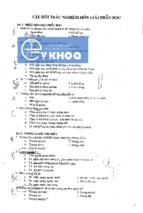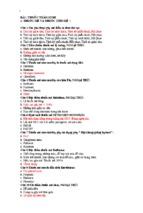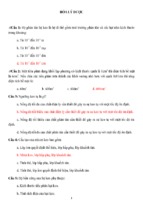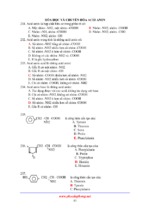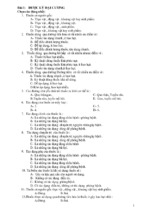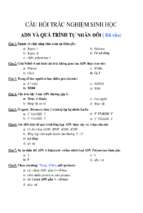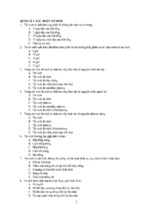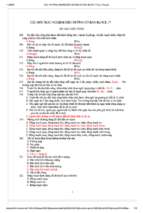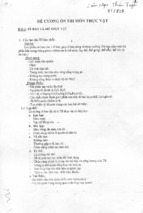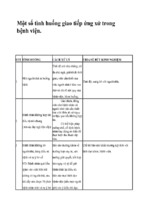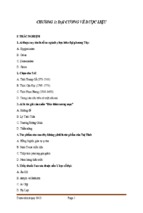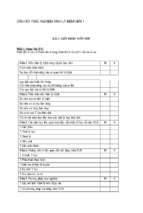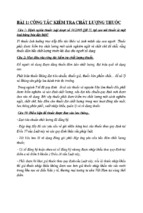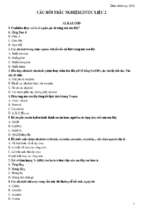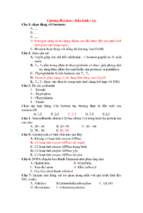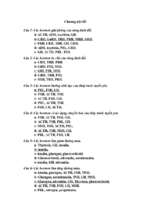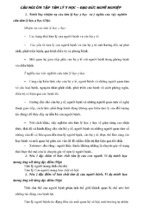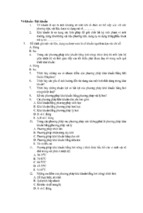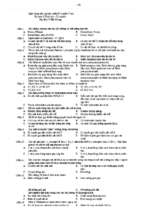Bài 2:Các hậu tố ( suffix)
Từ " suffix" có nguồn gốc latin, bắt nguồn từ từ "suffixium".Từ này có thể được
dịch nghĩa là "gắn vào phía sau hoặc phía cuối" Bởi định nghĩa này cho nên các
từ được gọi là hậu tố được đặt phía sau của một thuật ngữ.
Mặc dù suffix là hậu tố nhưng nó lại mang ý nghĩa chính của thuật ngữ và làm
rõ nghĩa cho thuật ngữ cho nên chúng ta sẽ học các suffix trước khi học các
root ,các prefix.
Bài trước tôi cũng có nói khi phân tích nghĩa của một thuật ngữ luôn luôn phải
phân tích ngược lại từ cuối trước rồi lên đầu sau đó trở về giữa.
VD appendicitis = inflammation(-itis) of the appendix/ viêm ruột
thừa.Appendix khi đứng một mình chỉ là ruột thừa với nghĩa nguyên bản,cái
ruột thừa có thể viêm có thể có u,có thể là đau cho nên phải phân tích ngược lại
từ cuối để hiểu tính chất muốn phản ánh của một thuật ngữ!
Phân loại hậu tố.
Để việc học được thuận tiện,người ta phân ra các nhóm sau:
1.Các vấn đề y khoa (conditions)
2.Các chẩn đoán,xét nghiệm,các thủ thuật y khoa (Procedures)
3.Các chuyên ngành y khoa,các chuyên gia y khoa (Specialties)
4.Các cách chuyển hậu tố từ danh từ sang tính từ.
I.CÁC VẤN ĐỀ Y KHOA
Suffix.....................................meaning
-algia....................................... pain (đau)
-cele.......................................... protrusion, hernia (thoát vị)
-dynia......................................... pain (đau)
-ectasis, -ectasia....................... expansion or dilation (mở rộng, giãn)
-emia......................................... blood (máu)
-iasis.................................... presence of; formation of (tạo thành)
-itis.......................................... inflammation (viêm)
-malacia.................................. softening (làm mềm)
-megaly..................................... enlargement (to ra)
-oma............................................ tumor (u)
-osis........................................ condition (tình trạng)
-penia..................................... reduction of size or quantity (giảm kích thước,số
lượng)
-plasia.................................... abnormal formation (tạo thành bất thường)
-plegia ............................................paralysis(liệt)
-ptosis.................................. downward displacement (di chuyền xuống)
-rrhage..................................... flowing forth, as occurs in a hemorrhage:
hem/a/t/o (blood) + -rrhage
-rrhea......................................... discharge (chảy dịch)
-rrhexis................................ rupture (vỡ)
-spasm............................. muscular contraction (co cơ)
-pnea................................... breath, respiration (hô hấp)
II.CÁC CHẨN ĐOÁN,XÉT NGHIỆM VÀ THỦ THUẬT Y KHOA
Suffix.....................................meaning
-centesis........................................ surgical puncture (chọc – dẫn lưu, châm cứu)
-desis............................................. surgical binding (nối)
-ectomy.......................................... surgical removal (cắt bỏ)
-gen, -genic, -genesis....................... origin, producing (tạo ra)
-gram............................................ written or pictorial record (bản ghi)
-graph........................................ device for graphic or pictorial recording (máy
ghi)
-graphy......................................... act of graphic or pictorial recording (quá
trình ghi)
-meter............................................. . device for measuring (thiết bị đo)
-metry ...............................................act of measuring (QT đo)
-pexy.............................................. ...... surgical fixation (sửa chữa)
-plasty............................................ ... surgical repair (tạo hình)
-rrhaphy .................................................. ...suture (khâu)
-scope............................................. .. device for viewing (thiết bị nhìn)
-scopy............................................. ... act of viewing (QT nhìn)
-tomy.............................................. ........ incision (rạch)
-tripsy .................................................. ....crushing
III.CÁC CHUYÊN NGÀNH VÀ CHUYÊN GIA Y KHOA
Các chuyên gia thường có các hậu tố sau:
-ist
-ian
-iatrist
-logist
Các chuyên ngành có các hậu tố sau:
-logy
-ics
-iatry
-iatrics
IV.CÁC HẬU TỐ BIỂU THỊ TÍNH TỪ
Không có một quy luật chuẩn chung nào cho vấn đề này,Tuy nhiên cũng có
những quy luật tuân theo sự phát âm trong tiếng Anh
VD: Chúng ta bỏ từ cuối cùng là "x" trong từ "appendix" và thay vào đó chữ "c"
để biểu thị tính từ appendic. Trong tiếng Anh chúng ta phát âm từ appendicitis,
còn từ appendixitis khi phát âm lại không giống tiếng Anh,tuy nhiên đôi khi
chúng ta vẫn chấp nhận từ appendixitis mặc dù không đúng quy luật phát âm.Từ
psychiatry chúng ta bỏ từ "y" sau đó thêm "ic" để được psychiatric là tính
từ..v.v.
Sau đây là một số hậu tố được chuyển từ danh từ sang tính từ:
-a c
-a l
-aneous
-a r
-ary
-derm
-eal
-eous
-iatric
-i c
-oid
-otic
-ous
-tic
-ular
V.MỘT SỐ QUY TẮC NGOẠI LỆ KHI CHUYỂN TỪ SỐ ÍT SANG SỐ
NHIỀU:
virus chuyển thành viruses
serum chuyển thành serums hoặc sera
bacterium(một con VK)............bacteria(nhiều con VK có thể là một họ) nhưng
nếu là bacteriae(nhiều họ vk)
các từ có tận cùng là "x" có thể được thêm "es"phía sau:appendix thành
appendixes,apex thành apexes v.v.
Hậu tố -oma nghĩa là "tumor" khi chuyển sang số nhiều đáng lẽ phải chuyển
thành omata nhưng nhiều người lại thêm "s" sau -oma thành omas
VD:Carcinoma đáng lẽ chuyển sang số nhiều là carcinomata nhưng nhiều người
ghi là carcinomas. Hiện tại chúng ta chấp nhận cả 2 cách này do thói quen.
Bài Tập
I.Hãy phân loại (danh, động, tính từ) và dịch các thuật ngữ sau sang tiếng Việt
1. anemia
3. stenosis
4. dystrophy
5. acidosis
6. Anesthesia/ Local anesthesia /General anesthesia
7. psychiatry
8. orthopedist
9. obstetrics
10. urology
11. pediatrics
12. dermatology
13. pharmacy
14. gynecology
15. Physiologic
16. local
17. cutaneous
18. lymphoid
19. cellular
20. basic
21. salivary
22. oral
23. rheumatoid
24. virile
25. anatomical
26. circular
27. exploratory
II.Tìm và dịch các thuật ngữ Y khoa sang tiếng việt
E.G., a 39-year-old archaeologist and university professor, returned from a 6month expedition in the rain forest of South America suffering from a
combination of physical symptoms and conditions that would not subside on
their own. He was fatigued yet unable to sleep through the night . He also had a
mild fever night sweats, occasional dizziness , double vision, and mild crampy,
abdominal pain accompanied by intermittent diarrhea. In addition, he had a
nonhealing wound on his ankle from an insect bite. He made an appointment
with his family doctor, an internist. On examination, E.G. was febrile (feverish)
with a temperature of 101°F. His heart and lungs were normal,with a slightly
elevated heart rate. His abdomen was tender to palpation (touch), and
his bowel sounds were active and gurgling to auscultation (listening with a
stethoscope). His skin was dry and warm.He had symmetrical areas of edema
(swelling) around both knees and tenderness over both patellae (kneecaps) . The
ulceration on his left lateral ankle had a ring of necrosis (tissue death)
surrounding an area of granulation tissue. There was a small amount of purulent
(pus-containing) drainage.E.G.’s doctor ordered a series of hematology lab
studies and stool cultures for ova and parasites. The doctor suspected a viral
disease, possibly carried bymosquitoes, indigenous to tropical rain forests. He
also suspected a form of dysentery typically caused by protozoa . E.G. was also
possibly anemic , dehydrated ,and septic (infected). The doctor was confident
that after definitive diagnosis and treatment, E.G.would gain relief from
hisinsomnia, diplopia (double vision), and dizziness.
III.Chọn đáp án đúng
1. Diplopia, the condition of having double vision, has the suffix:
a. lopia
b. opia
c. ia
d. pia
e. plopia
2. The adjective septic is formed from the noun:
a. sepsis
b. septosis
c. septemia
d. septery
e. anemia
3. E.G. was suspected of having anemia (diminished hemoglobin). The
adjective form of the noun anemia is _____________, and the field of health
science devoted to the study of blood is called _______________.
a. anemic; hematology
b. hematosis; hematism
c. dehemia; hematomegaly
d. anemic; parasitology
e. microhematic; hemacology
IV.Ôn tập
Write the suffix that means “condition of” in each of the following words:
4. necrosis....................
5. dysentery.......................
6. insomnia..........................
Write the adjective ending of each of the following words:
7. febrile.......................
8. symmetrical....................
9. anemic....................
Write the singular form of each of the following words:
10. patellae...................
11. ova...................
12. protozoa..................
Write a word from the case study that means each of the following:
13. The word virus used as an adjective..................
14. The noun form of the adjective necrotic....................
15. Expert in the field of archeology....................
16. Expert in the field of internal medicine....................
17. The noun abdomen used as an adjective....................
- Xem thêm -

